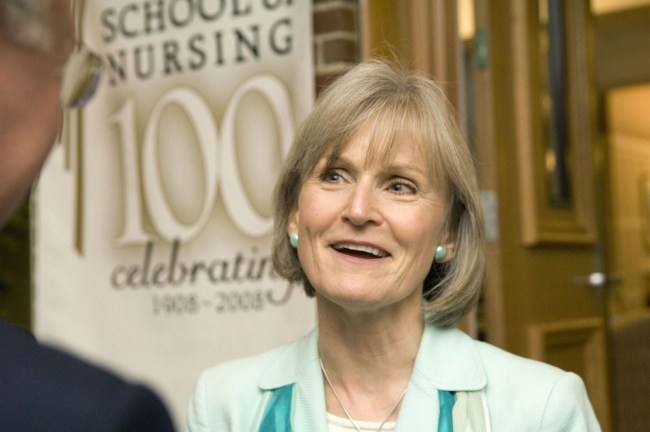
Mary Wakefield, Ph.D., R.N., administrator for Health Resources and Services Administration, delivered last week’s VUSN Centennial Lecture, the final installment in the series. (photo by Susan Urmy)
Centennial speaker sees ‘new day’ in health care
Vanderbilt University School of Nursing wrapped up its Centennial Lecture Series with a special presentation by Mary Wakefield, Ph.D., R.N., administrator for Health Resources and Services Administration (HRSA), who oversees a more than $7 billion organization that provides care to 17 million people.
Named to her position by President Obama in February, Wakefield described a “significant shift in how HRSA is received by the White House and by Capitol Hill” and “new energy at the agency and a fresh set of assignments and expectations.”
“We are pushing the refresh button; it's very much a new day,” she said. Wakefield believes that the future of primary health care reform may look a lot like the offerings of one of the 7,500 HRSA community health centers throughout the country.
In a nutshell, HRSA is charged with ensuring delivery of primary health care to thousands of medically and geographically underserved communities. Its reach is extensive, as each year one out of 18 people seeks the care of a doctor, nurse or dentist at a primary care clinic supported by the agency.
She commented on the president's Economic Recovery Plan and the proposed 2010 budget to show where the agency anticipates focusing its efforts.
“With the economic downturn, the pressure on these community health centers is just enormous. It was significant before, but much more significant at this point. Dollars are being used very directly to keep the doors open,” said Wakefield, former dean of rural health at the University of North Dakota.
HRSA received $2.5 billion in funds from the plan, which has translated into 126 new community health centers, aid to 338 current health centers to extend hours, programs and services, and aid to additional centers to improve and expand sites, equipment and technology.
Additionally, $500 million is being spent on workforce development to ensure that there is a steady stream of health care providers educated and available in the neediest of rural and urban communities.
According to Wakefield, the 2010 federal budget recommendations set the stage for health care reform by including proposals such as $1 billion for expanding the scholarships and loans for health care providers willing to practice in underserved areas, enhancing the capacity of nursing schools, improving opportunity for minority and low income students and ensuring access to care for seniors.
It also includes a $34 million increase (up from $135 million) for the National Service Corps, a loan forgiveness program for health care practitioners who serve in underserved areas, and an $88 million increase (up from $37 million) to expand the nurse loan repayment program.













